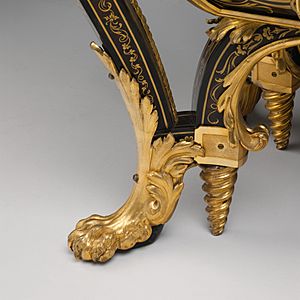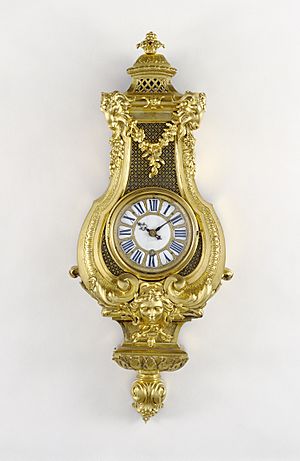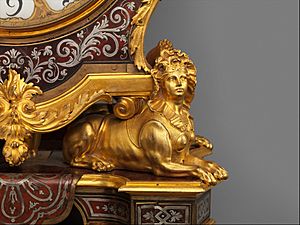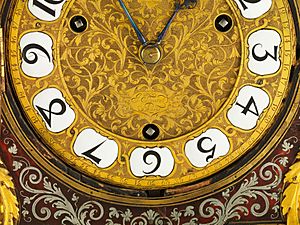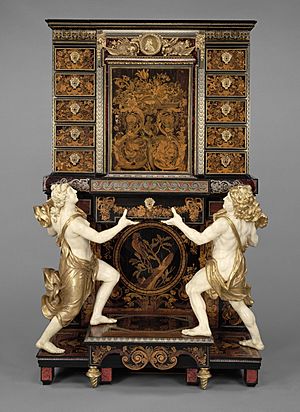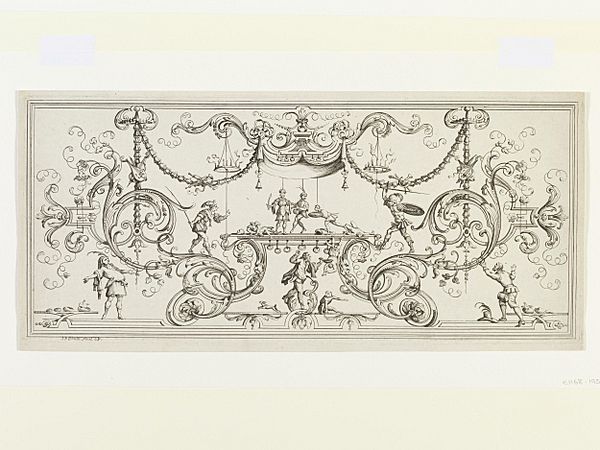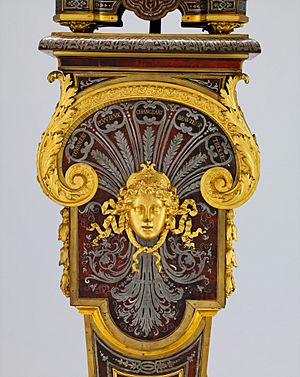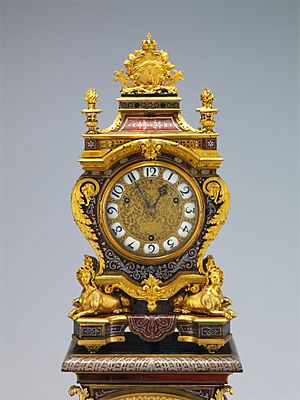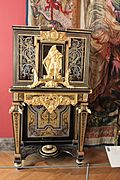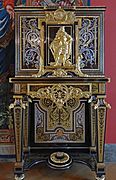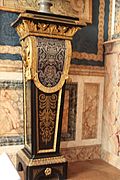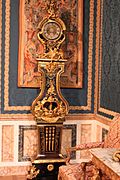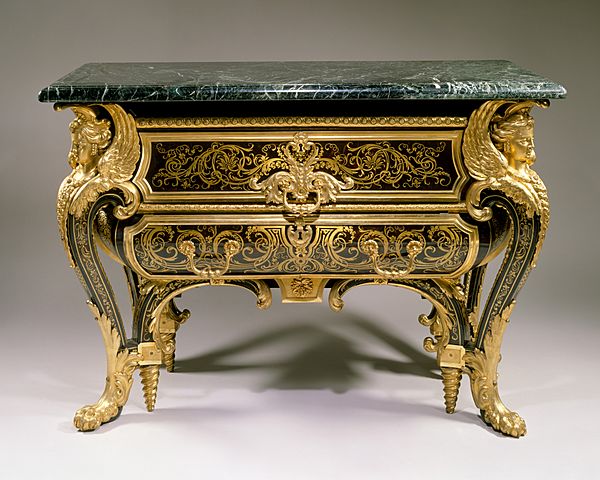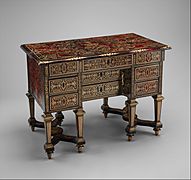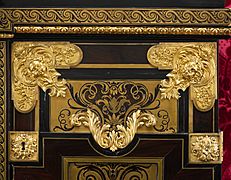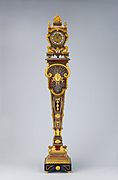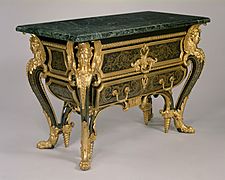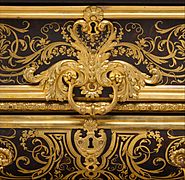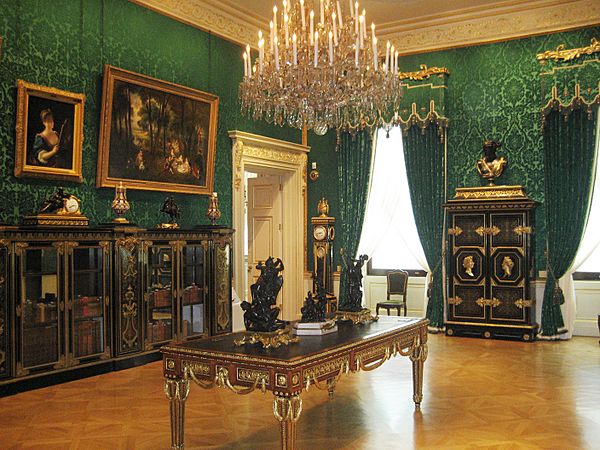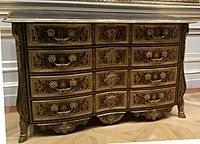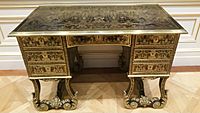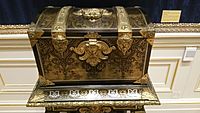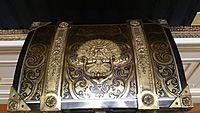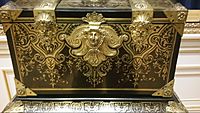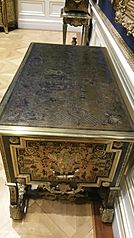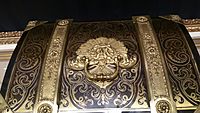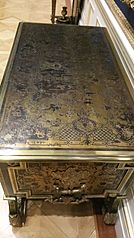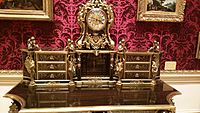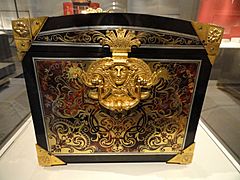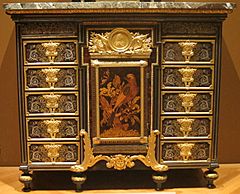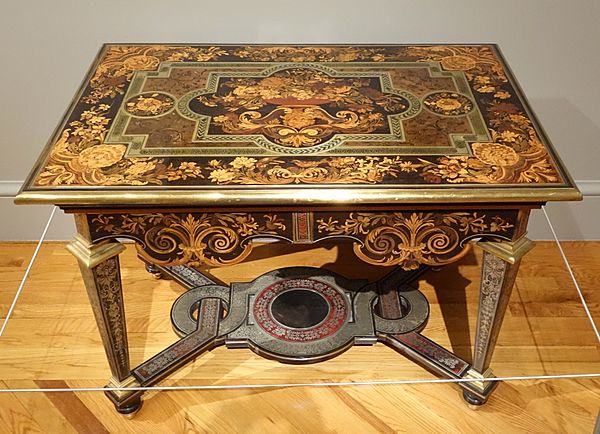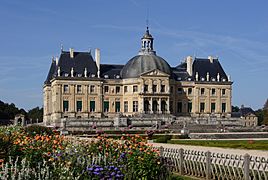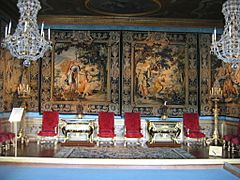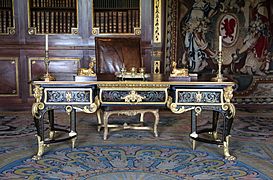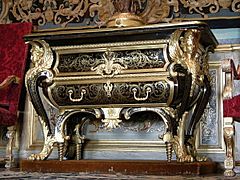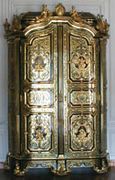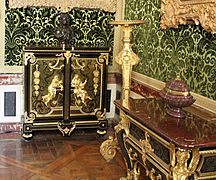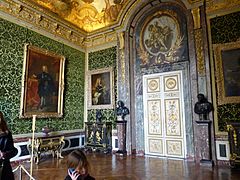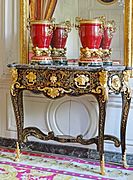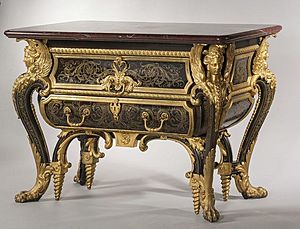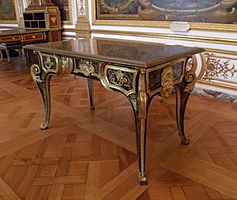André Charles Boulle facts for kids
André-Charles Boulle (born November 11, 1642 – died February 29, 1732) was a very famous French cabinetmaker. People called him "the furniture jeweller" because he was so good at making beautiful furniture. He was especially known for his amazing "inlay" work, also called marquetry. This is a special way of decorating furniture by setting pieces of different materials into its surface.
Boulle was considered the best French cabinetmaker of his time. Jean-Baptiste Colbert, a powerful minister, even recommended him to Louis XIV of France, the "Sun King" (who ruled from 1643 to 1715). Colbert said Boulle was "the most skilled craftsman in his profession".
Even today, Boulle's name is linked to the special art he made perfect: inlaying tortoiseshell, brass, and pewter into ebony wood. This style is now known as Boulle Work. There's even a famous school in Paris, the École Boulle (started in 1886), that teaches fine arts and crafts and applied arts. It's named after him to honor his lasting artistic legacy.
Contents
Life of a Master Craftsman
André-Charles Boulle stated his birth date as November 11, 1642, on his marriage certificate in 1677. However, historians have found it hard to confirm this date or his birthplace in Paris. His father, Jean Boulle, was also a cabinetmaker.
Boulle's family background was artistic. His father and grandfather were both cabinetmakers to the King and lived in the Louvre palace by royal permission. This meant André-Charles grew up surrounded by talented artists, master craftsmen, and engravers. His aunt was even a famous painter! This artistic environment surely helped him become the genius he was.
One reason his early life is a bit of a mystery is because of the times. In 1685, King Louis XIV made Protestantism illegal in France. Many Protestants had to leave the country or pretend to be Catholic. Some artists, like the royal musician Jean-Baptiste Lully, even changed their names to fit in. This makes it tricky for historians to trace Boulle's family history accurately.
It's thought that Boulle might have been a bit messy with dates himself. When he died, his children even said he was 90, which is probably not true! This adds to the confusion about his exact birth year.
By 1672, when he was about 30, Boulle was given special workshops in the Louvre palace. This was a huge honor from Louis XIV, given only to the most favored artists working for the King. This special status also meant he didn't have to follow the strict rules of the regular trade guilds.
The King's minister, Jean-Baptiste Colbert, called Boulle "the most skilled cabinetmaker in Paris." The royal document giving him his workshop even described him as a "chaser" (someone who decorates metal), "gilder" (someone who applies gold), and a maker of marquetry. He was given the important job of Premier ébéniste du Roi (First Cabinetmaker to the King).
Boulle originally wanted to be a painter, but his father encouraged him to focus on other skills. This might be why he became so passionate about collecting art, like paintings and prints. He spent a lot of money on these collections, which sometimes caused him financial problems.
He worked for many years at the Versailles palace, creating amazing inlaid walls, wood mosaic floors, and decorated panels. These works were considered some of his best. Many important people, from foreign princes to French nobles, wanted Boulle to make furniture for them.
Even though Boulle was incredibly skilled and charged high prices, he often ran out of money. This was mainly because he loved collecting art so much. He would spend huge amounts on paintings, drawings, and other art objects. This meant he sometimes couldn't pay his workers on time, and clients had to wait a long time for their furniture. He even got into trouble with his creditors (people he owed money to). In 1704, the King had to give him six months to sort out his finances.
In 1720, a fire destroyed one of his workshops in the Louvre. He lost many tools, precious wood, and finished artworks, including valuable old paintings and drawings. His friend, Pierre-Jean Mariette, said Boulle's money problems were truly because of his "obsession" with collecting art.
André-Charles Boulle died on February 29, 1732, still living in the Louvre. He left many debts for his four sons to handle. He had already given them control of his business seventeen years earlier.
Family of Craftsmen
André-Charles Boulle had four sons: Jean-Philippe, Pierre-Benoît, André-Charles II, and Charles-Joseph. They took over his workshops and learned his techniques as early as 1715. All four sons were given the special title of ébéniste du roi (cabinetmaker to the King). However, like their father, they also struggled with money, and three of them died in debt.
Boulle Work: A Special Inlay Style
Boulle's special inlay technique used materials like tortoiseshell, brass, pewter, and sometimes even animal horn. For the wood parts, he often chose dark, rich woods like rosewood and ebony.
Here's how his marquetry technique worked: He would make a "sandwich" of two contrasting materials, like a light layer and a dark layer. Then, he would cut a detailed design through both layers at once. This created two matching pieces:
- One piece would have the light pattern on a dark background. This was called the 'première partie' (first part).
- The other piece would have the dark pattern on a light background. This was called the 'contrapartie' (counterpart).
By doing this, the background of one design became the main pattern of the other. Boulle would sometimes use both patterns on the same piece of furniture, or he would make a pair of matching cabinets, each with a different pattern.
Tortoiseshell

Tortoiseshell was used in thin slices for inlaying onto wood. It was rare and expensive, but it was strong, felt warm, and had a beautiful mottled red color. It looked especially good with dark woods like ebony and gave Boulle's work a sense of depth.
Brass (Gilt Bronze)
Boulle was also skilled in working with metal. He could create and cast his own gilt-bronze (bronze covered in a thin layer of gold) decorations for his furniture. From 1685, he even had his own metal workshop. This was very important because it meant he could make unique and original designs for his furniture's metal parts. Boulle also made other objects purely from gilt-bronze, like chandeliers and clocks, which added to his fame.
Pewter
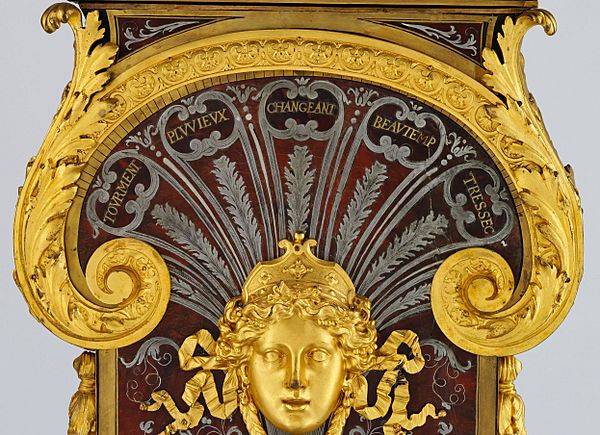
When pewter or brass was inlaid onto tortoiseshell, it was called premier-partie. When tortoiseshell was inlaid onto brass or pewter, it was called contre-partie. Sometimes, Boulle would add mother-of-pearl, stained horn, or dyed tortoiseshell to make the designs even more luxurious.
Famous Works
André-Charles Boulle didn't keep good records of all the furniture he made. This makes it hard for experts to know for sure if a piece is truly from his workshop. His sons continued his style after he died, and many other artists also copied his work.
However, some of his most magnificent pieces are known worldwide. For example, a pair of commodes (chests of drawers) delivered to the King at the Grand Trianon in 1708 and 1709 are definitely confirmed as his. There are also large armoires (wardrobes) in the Louvre Museum and the Wallace Collection that are known to be from his workshop.
We can sometimes identify Boulle's work by looking at the detailed marquetry, the way he reused certain design patterns, and his bold gilt-bronze decorations. Some of his designs were even published in books by his friend Pierre-Jean Mariette.
Boulle's beautiful work, with its tiny pieces of ivory, copper, ebony, and tortoiseshell, was often glued onto softer wood. This means these delicate pieces can be damaged by changes in temperature and humidity over time. Because they were so fragile and valuable, they were often kept in special places and not used much.
Where to See Boulle's Art Today
You can find André-Charles Boulle's incredible furniture in many famous museums and palaces around the world.
The Louvre
Here are some of André-Charles Boulle's artworks displayed at the Louvre Museum in Paris:
The Metropolitan Museum of Art
Indianapolis Museum of Art
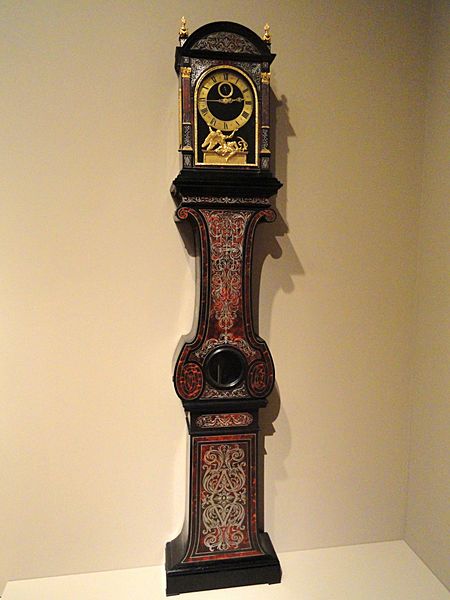
The Wallace Collection
Some of Boulle's most amazing works are shown in the Large Drawing Room of the Wallace Collection in London:
The Art Institute of Chicago
-
A casket from the early 18th century, thought to be by Andre-Charles Boulle, at The Art Institute of Chicago.
The Cleveland Museum of Art
-
A cabinet from around 1690, made of ebony, metal, and tortoiseshell by André-Charles Boulle, at the Cleveland Museum of Art.
The Legion of Honor Museum
The Calouste Gulbenkian Museum
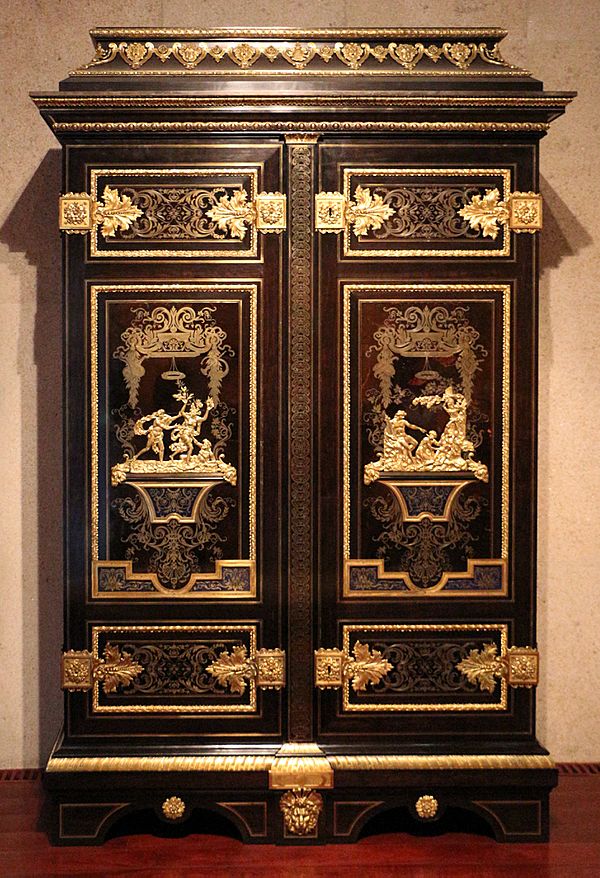
The Victoria and Albert Museum
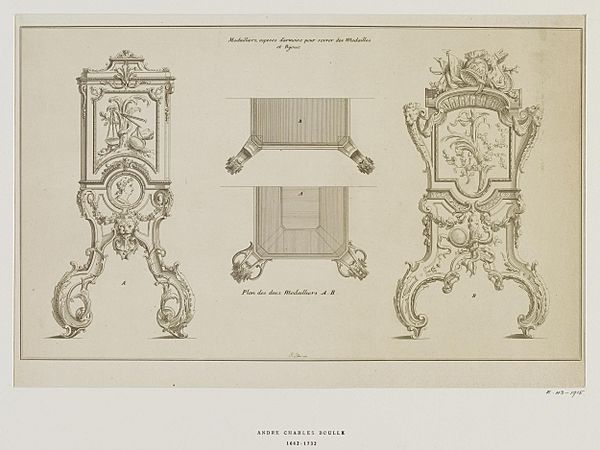
The J. Paul Getty Museum
Boulle's Art in Châteaux
You can also find Boulle's magnificent furniture in grand French castles.
Château de Vaux Le-Vicomte
Château de Versailles
Grand Trianon
Boulle delivered the first versions of the Mazarin Commode to the Grand Trianon in 1708. King Louis XIV loved them! The design became very popular, even though it was a bit heavy and needed extra legs to support the bronze and marble. Boulle's workshop made at least five more of these commodes between 1710 and 1732.
Château de Chantilly
Waddesdon Manor
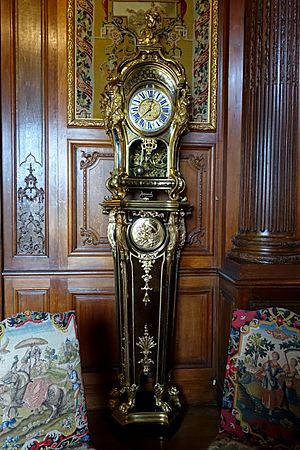
The Royal Collection & Windsor Castle
Most of the furniture by or thought to be by Boulle in the Royal Collection was bought by King George IV (who lived from 1762–1830). He loved French furniture and filled his palaces with it. Boulle's fancy style and use of unique materials fit perfectly with the King's taste.
It can be hard to say for sure if a piece is by Boulle because he didn't sign his work, and many copies were made later. Because of this, many Boulle-style pieces in the Royal Collection are listed as "attributed to André-Charles Boulle." There are at least 13 of his works in the Royal Collection, including armoires, cabinets, and writing tables at Windsor Castle.
Images for kids
-
Design for a marquetry panel by Jean-Philippe Boulle, the Oldest Son of André-Charles Boulle.
-
Boulle Work showing the use of pewter (center) and the 'depth' given by tortoiseshell in the background. Brass Inlay is on the right and left.
See also
 In Spanish: André-Charles Boulle para niños
In Spanish: André-Charles Boulle para niños




